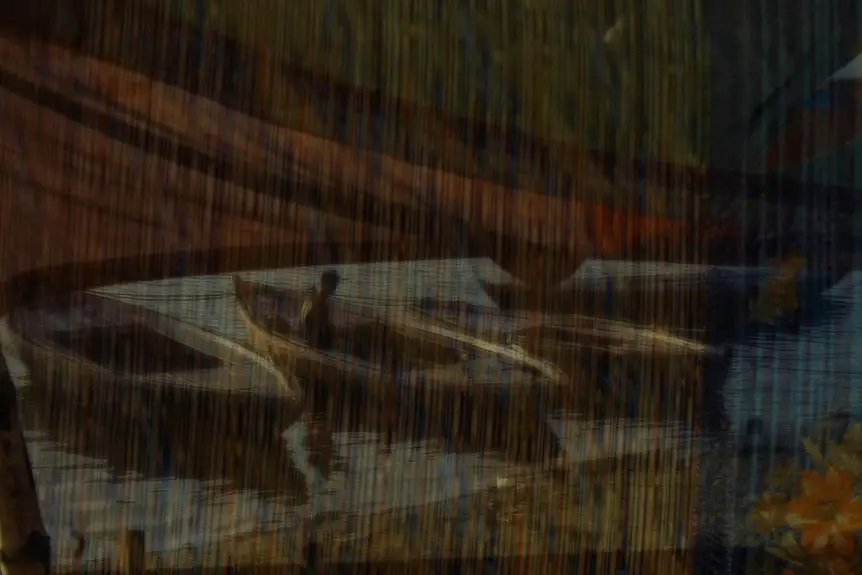Tapestry fabric is made by weaving fibers like wool, cotton, silk, linen, or even synthetic materials. Wool is common for strength and vibrant colors, while silk adds sheen but is less durable. The fabric’s unique texture comes from intertwining strong warp threads with decorative weft threads, blending artistry with durability. Whether handwoven or machine-made, each tapestry’s fiber choice shapes its look and feel. Keep exploring, and you’ll uncover more about the techniques, materials, and care behind these rich fabrics.
Table of Contents
Key Takeaways
- Tapestry fabric is primarily made from wool, valued for its strength and vibrant color retention in weaving.
- Cotton and linen are common fibers used for added durability and texture in tapestry compositions.
- Silk fibers contribute a luxurious sheen but are less durable compared to wool in tapestry fabric.
- Synthetic fibers like acrylic and polyester are sometimes blended to enhance durability and reduce production costs.
- The combination of warp (foundation) and weft (design) threads defines tapestry fabric’s texture, strength, and visual appeal.
Origins and Historical Background of Tapestry Fabric
Although tapestry fabric has evolved over centuries, its origins trace back to ancient civilizations where artisans wove intricate designs to tell stories and decorate spaces.
When you look at tapestry’s history, you’ll see it began as a practical art form, combining utility with beauty. You’d find early examples in Egypt, Greece, and Rome, where craftsmen used weaving to depict myths, battles, and daily life.
As you explore further, medieval Europe stands out, especially during the Gothic period, when tapestries adorned castles and cathedrals, showcasing religious and historical themes.
You’ll notice how these pieces weren’t just decorative—they also insulated large stone walls. Understanding this background helps you appreciate tapestry not just as fabric, but as a storytelling medium with deep cultural roots.
Common Fibers Used in Tapestry Weaving
When you explore tapestry weaving, you’ll find that the choice of fibers plays an essential role in the final texture and durability.
Wool is the most common fiber used because it’s strong, flexible, and holds dye well, giving vibrant colors. Cotton also appears frequently, offering smoothness and added strength.
Wool offers strength and vibrant colors, while cotton provides smoothness and extra durability in tapestry weaving.
Silk adds a luxurious sheen and softness, though it’s less durable than wool. Linen, made from flax, provides a crisp texture and longevity but can be stiffer.
Sometimes, tapestries incorporate synthetic fibers like acrylic or polyester to boost durability and reduce costs.
Each fiber affects the tapestry’s feel, appearance, and lifespan, so understanding these options helps you appreciate the craftsmanship behind each piece and choose the right fabric for your needs.
Traditional and Modern Weaving Techniques
You’ll notice that tapestry weaving has come a long way from traditional handweaving to modern machine techniques.
Each method brings its own qualities and challenges to the fabric’s texture and durability.
Let’s explore how these weaving methods have evolved over time.
Handweaving vs. Machine Weaving
Understanding the differences between handweaving and machine weaving can help you appreciate the unique qualities each technique brings to tapestry fabric. Handweaving involves manually interlacing threads, giving each piece character and slight irregularities, while machine weaving uses automated looms for precision and speed. Both methods affect texture, durability, and design intricacy differently.
| Aspect | Handweaving |
|---|---|
| Speed | Slow, labor-intensive |
| Texture | Irregular, unique |
| Design Flexibility | High, allows customization |
| Durability | Varies with skill |
| Cost | Generally higher |
| Aspect | Machine Weaving |
| Speed | Fast, efficient |
| Texture | Uniform, consistent |
| Design Flexibility | Limited by machine settings |
| Durability | Consistent |
| Cost | Usually lower |
Evolution of Weaving Methods
Although weaving has ancient roots, its methods have continuously evolved to meet changing needs and technologies.
You’ll find that traditional tapestry weaving relies on manual looms, where artisans carefully interlace threads to create detailed patterns. This hands-on technique allows you to achieve unique textures and intricate designs that machines can’t easily replicate.
However, as technology advanced, mechanized looms emerged, speeding up production and making tapestry fabrics more accessible.
Today, you can choose between handwoven pieces that reflect craftsmanship or machine-made tapestries offering consistency and affordability.
Understanding this evolution helps you appreciate how weaving balances artistry with efficiency, ensuring tapestry fabric remains both a functional and decorative textile in modern times.
The Role of Warp and Weft Threads
You’ll notice that warp threads provide the sturdy foundation for tapestry fabric, running lengthwise to hold everything in place.
Meanwhile, weft threads move across the warp, creating the design and texture you see.
Understanding how these threads work together helps you appreciate the fabric’s strength and artistry.
Warp Thread Characteristics
Three key qualities define warp threads in tapestry weaving: strength, tension, and alignment. You rely on warp threads to form a sturdy foundation, so they need to be strong enough to withstand constant pulling. Maintaining consistent tension prevents distortion in your design, guaranteeing the final tapestry stays true to your vision. Proper alignment keeps warp threads evenly spaced, which is essential for the weaving process.
Here’s a quick summary:
| Quality | Importance |
|---|---|
| Strength | Supports the entire fabric structure |
| Tension | Maintains shape and prevents sagging |
| Alignment | Guarantees even spacing for neat weaving |
Weft Thread Functions
Weft threads play a crucial role in tapestry weaving by interlacing with the warp threads to create the fabric’s visible pattern and texture.
When you work with tapestry, the warp threads remain taut and vertical, forming the structural foundation. The weft threads, however, move horizontally, weaving over and under the warp threads. This action allows you to build intricate designs and add color variations.
Unlike warp threads that provide strength, your weft threads define the visual appeal and thickness of the tapestry. You can use different materials and thicknesses for weft threads to achieve various textures or effects.
Fundamentally, you rely on the interplay between warp and weft threads to craft a durable yet artistic tapestry fabric.
Natural Vs Synthetic Materials in Tapestry Production
Although both natural and synthetic materials have their unique strengths, choosing between them greatly impacts the look, feel, and durability of your tapestry.
Natural fibers like wool, cotton, and silk offer warmth, breathability, and a traditional aesthetic. They often age beautifully, developing a unique patina over time.
Natural fibers such as wool, cotton, and silk provide warmth, breathability, and develop a beautiful patina with age.
On the other hand, synthetic fibers such as polyester and acrylic provide increased strength, resistance to fading, and easier color retention. They can mimic natural fibers’ texture but tend to be more affordable and less prone to shrinking or stretching.
When selecting materials, consider how you want your tapestry to perform and age. Natural fibers bring authenticity and softness, while synthetics deliver durability and vibrancy—your choice ultimately shapes your tapestry’s character and longevity.
Care and Maintenance of Tapestry Fabrics
Because tapestry fabrics combine various fibers and intricate designs, proper care is essential to maintain their beauty and longevity.
You should avoid direct sunlight to prevent fading and keep them away from moisture, which can cause mold or mildew.
Regularly dust your tapestry with a soft brush or vacuum it on a low suction setting using a brush attachment.
If stains occur, spot clean gently with a mild detergent and cold water—never soak the fabric.
For deep cleaning, it’s best to consult a professional familiar with delicate textiles.
When storing, roll your tapestry instead of folding to avoid creases and place it in a breathable fabric cover.
Following these steps helps preserve your tapestry’s texture, color, and intricate patterns for years to come.
Frequently Asked Questions
How Is Tapestry Fabric Used in Contemporary Interior Design?
You use tapestry fabric in contemporary interior design to add texture and visual interest to walls, cushions, or upholstery. It brings warmth and artistic flair, making spaces cozy while showcasing unique patterns and craftsmanship.
What Are the Environmental Impacts of Tapestry Production?
You’ll find tapestry production can impact the environment through water use, chemical dyes, and energy consumption. Choosing eco-friendly materials and sustainable practices helps reduce these effects, letting you enjoy beautiful tapestries responsibly.
Can Tapestry Fabric Be Recycled or Repurposed?
You can definitely recycle or repurpose tapestry fabric, especially by turning old pieces into cushions, bags, or wall art. Don’t throw them away—get creative and give your tapestry a new life instead of adding waste.
How Do Tapestry Patterns Influence Cultural Storytelling?
You’ll find tapestry patterns act like visual stories, reflecting cultural values and history. They pass down traditions, legends, and identities, letting you connect deeply with a culture through intricate symbols and scenes woven into the fabric.
What Are the Common Challenges in Dyeing Tapestry Fibers?
You’ll face challenges dyeing tapestry fibers since 60% of colors fade within a year. You’ll struggle with uneven absorption, colorfastness, and fiber damage, so you’ve got to carefully select dyes and control temperature and time for vibrant results.
- The Unique Properties of Silk Crepe De Chine Fabric - June 20, 2025
- How to Buy Chino Fabric By the Yard: Top Online and In-Store Options - June 20, 2025
- A Guide to China’s Flourishing Velvet Fabric Trade - June 20, 2025



